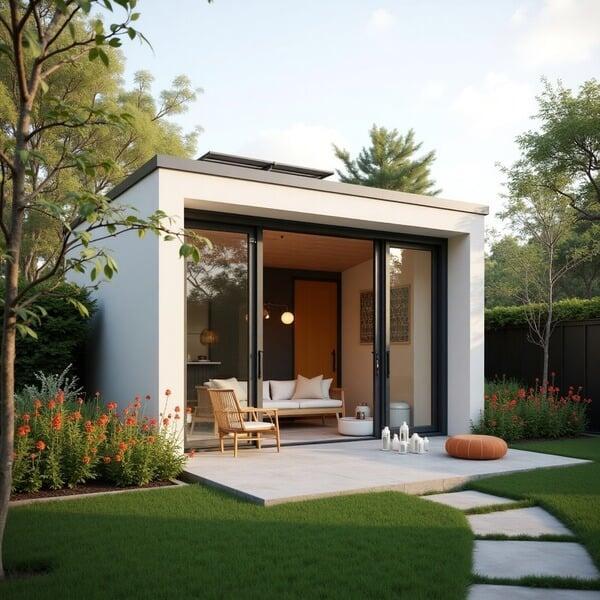| Table of Content |
| 1. What is an ADU? |
2. Benefits of Building a Permitted ADU in California |
| 3. What Is an Unpermitted ADU? |
| 4. Risks of Having an Unpermitted ADU |
| 5. Why Legalize Now? California’s Pro-ADU Climate |
| 6. How to Legalize an Unpermitted ADU in California |
| 7. Cost to Legalize an Unpermitted ADU |
| 8. FAQ |
As California faces an ever-growing housing shortage, Accessory Dwelling Units (ADUs) have become one of the most popular and affordable solutions. They offer homeowners extra living space, potential rental income, and the ability to house family members on the same property.
But what happens when an ADU was built without a permit?
If you're in this situation, you're not alone. Thousands of Californians are sitting on unpermitted ADUs—many built before the recent housing reforms. The good news? State and local governments are making it easier to legalize these structures through updated laws and amnesty programs.
This guide provides everything you need to know about how to legalize an unpermitted ADU in California—from understanding ADU basics to navigating the retroactive permitting process.

✅ Benefits of Building a Permitted ADU
Legalizing or building a permitted ADU offers a wide range of advantages:
✅ Increase Property Value – A legal ADU adds resale and appraisal value.
✅ Earn Legal Rental Income – Renting without permits is risky and illegal.
✅ Peace of Mind – No worries about fines or code enforcement.
✅ Insurance and Financing – Permitted units qualify for insurance, loans, and refinancing.
✅ Safety and Code Compliance – Ensures the unit is structurally safe and habitable.
🚫 What Is an Unpermitted ADU?
An unpermitted ADU is a unit constructed without obtaining the proper building, zoning, or safety approvals from your local city or county. This could involve:
Skipping plan review and inspections
Failing to meet zoning codes or setbacks
Using substandard construction materials or methods
Inadequate plumbing, electricity, or egress
⚠️ Risks of Having an Unpermitted ADU
An unpermitted ADU may function in the short term, but it carries long-term legal and financial risks:
💸 Fines and Penalties – Cities can issue violations or daily fines.
🔨 Demolition Orders – You may be required to remove or rebuild the unit.
🚫 Rental Restrictions – Illegal units cannot be rented legally.
🔍 Disclosure Risks – During resale, lack of permits must be disclosed, potentially lowering your home’s value.
🧯 Safety Issues – Non-compliance with fire, electrical, and structural codes puts occupants at risk.
🔁 Why Legalize Now? California’s Pro-ADU Climate
In recent years, California has passed several ADU-friendly laws to simplify legalization:
Key Legislation:
SB 13 (2020): Prohibits impact fees on ADUs under 750 sq. ft.
AB 68 & AB 881: Reduces barriers to ADU approvals and prohibits owner-occupancy requirements.
AB 1033 (2023): Allows for ADU-to-condo conversions in some cities.
Local Amnesty Programs: Cities like Los Angeles, San Diego, and San Jose offer limited-time amnesty or penalty waivers to bring illegal ADUs into compliance.
📋 How to Legalize an Unpermitted ADU in California (Step-by-Step)
Step 1: Assess the ADU’s Current Condition
Hire a licensed contractor or architect to evaluate:
Structural integrity
Electrical, plumbing, and HVAC systems
Ceiling height and egress
Compliance with fire and building codes
Step 2: Contact Your Local Building Department
Ask about:
Retroactive permitting options
Required documentation
Penalty fee structure
Eligibility for amnesty programs
Step 3: Prepare “As-Built” Plans
You’ll need architectural drawings that show the ADU as it currently exists. These are submitted for review as part of your retroactive permit application.
Step 4: Apply for a Retroactive Permit
Submit your as-built plans, pay initial fees, and follow up on:
Zoning review
Health and safety inspections
Code corrections
Step 5: Complete Required Upgrades
This could include:
Smoke/carbon monoxide detectors
Proper plumbing/electrical systems
Title 24 energy compliance
Egress windows or access improvements
Step 6: Final Inspection & Certification
Once your upgrades pass inspection, the city will issue a Certificate of Occupancy—making your ADU fully legal.
📊 Cost to Legalize an Unpermitted ADU
| Expense Type | Estimated Cost |
|---|---|
| Plans & Drawings | $2,000 – $6,000 |
| Permit & Impact Fees | $1,500 – $10,000 |
| Required Construction Upgrades | $5,000 – $50,000+ |
| Total (avg. range) | $8,500 – $60,000 |

